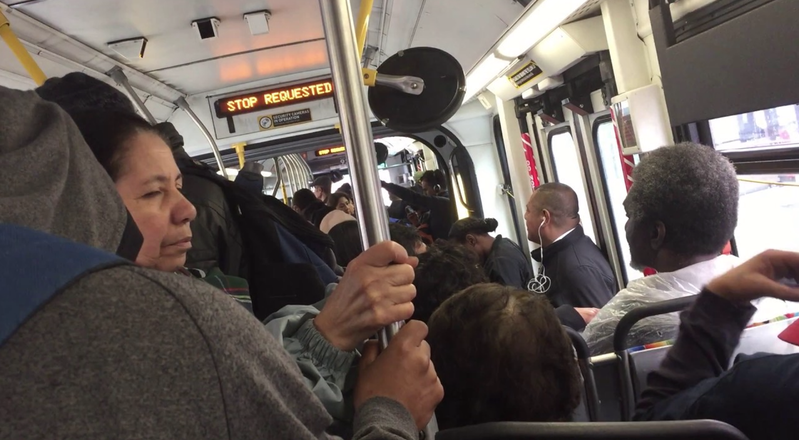CommentsTRANSIT TALK-As I have asked before, “Who is in charge of bus stops?” I ask this because as a regular bus rider in Los Angeles since 1992 I have experienced too many instances of bus stops being closed without advance notice, throwing my transit life into chaos and stress.
To find out who is in charge of bus stops, and if there is anyone looking out for bus riders’ interests, I contacted city, county and state governmental offices to pose these questions and find out if anyone is working on creating a better bus riding situation. In the over ten months since I contacted these offices, I have heard back from none.
Governments, corporations and environmental groups say we should ride buses and trains to reduce our carbon footprints, to combat the quickly growing threat of climate change through global warming. I agree, and have been a steady bus rider since 1992, but over those years I question if those saying we should ride buses regularly do so themselves.
From my experience, I think not.
In addition to the closing of bus stops for road construction without notice, or the bus stops being blocked by delivery trucks and ride share cars, there is another critical issue for bus riders: Those who promote riding the bus seem to have little or no knowledge about the bus back door or (for the longer, articulated buses) back doors.
The back door is critical to making travel times by bus. At a bus stop, a queue forms, and riders enter the bus through the front door, pay their fares, then find a seat. Despite the prophesy of doom from critics that bus riding is becoming unnecessary due to low ridership numbers, there are many times when I ride and all seats are taken, so I end up standing.
The seats in the front are designated for Senior Citizens and Disabled -- including bus riders with a walker or using a wheelchair. The rest find seats towards the rear of the bus. When exiting, riders should exit by the back door. If they don’t, they then squeeze through the riders already standing, and those trying to enter.
This slows down travel time.
Exiting through the rear of the bus is highly efficient once the rider gets to the back door. It is when they exit the bus that troubles begin.
First, buses are higher than sidewalks, so careful navigation is needed to span the distance. Then, in too many instances there are a series of obstacles preventing a quick and safe exiting of the bus. Such as:
- Broken, uneven sidewalks, creating a hazard of a twisted ankle or knee, or worse, a fall. Navigating this slows down departures, thus, slowing the bus.
- There is a tree and roots directly in front of the bus door, creating another obstacle similar to a broken uneven sidewalk. To navigate this slows down departures, thus, slowing the bus.
- There is a city trash can in front of the back.
- The back door is over a sidewalk cutout for a driveway, making the distance between the bus and sidewalk even greater, and thus requiring a leap to exit the bus. When it is raining this distance is treacherous.
- The back door opens to a grass lawn which can be wet and slippery, and adding to this obstacle, the sprinklers may be on.
- Not all bus back doors open automatically, so the rider pushes the yellow tape to exit. This can be confusing to new riders and slows down the exit. If there is an obstacle in front of the bus rider slowing their exit, the doors will slam shut on the rider before they have completely exited, which then they need to slam back open.
- There are the greatly detested e-scooters and dockless e-bikes blocking exit from the back door.
- There is a heap of trash on the sidewalk.
- The exit is on to a very narrow sidewalk.
There are Federal guidelines on the placement of bus stops. These guidelines seem to be somewhat in the interest of the rider, but there does not seem to be any guidance, nor the least bit of forethought or care from bus agencies and cities that have bus stops, concerning the needs and requirements of bus riders to create a quick, obstacle free, safe exit from the back of the bus.
Bus drivers are instructed to stop at the posted bus signs. This makes the front door accessible but leaves the back door to deal with the various obstacles we bus riders face.
But bus drivers are human, and they cannot stop exactly as needed each time at each bus stop. No one in Major League Baseball bats one thousand, and the last hitter to reach a 400 batting average was Ted Williams in 1941. Bus drivers cannot be expected to park exactly correctly at each stop each time, particularly with the obstacles they face from other drivers.
The problems of the back door of the bus have greater odds of being an obstacle when no one, or no agency, seems concerned about bus riders and their riding experience.
Is there anyone or any agency in charge of bus stops looking after the needs of bus riders?
(Matthew Hetz is a Los Angeles native. He is a transit rider and advocate, a composer, music instructor, and member and president and executive director of the Culver City Symphony Orchestra.) Edited for CityWatch by Linda Abrams.
















